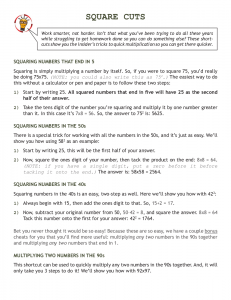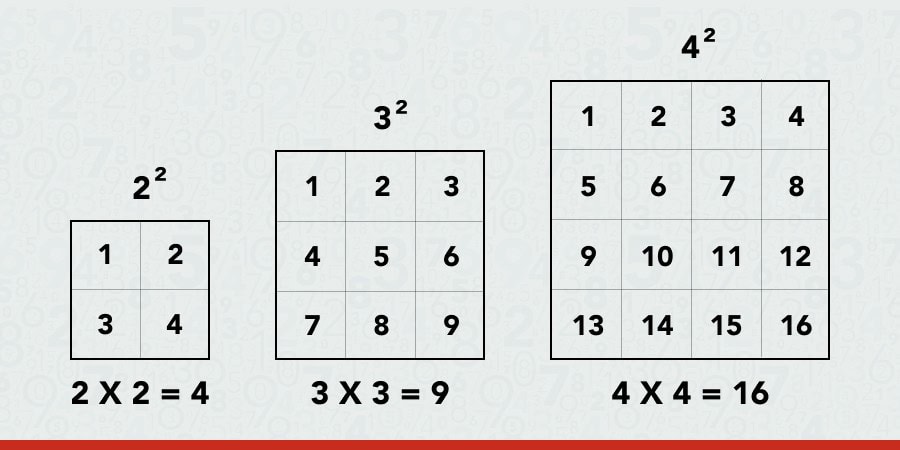Imagine being in front of a sea of bored, teenage eyes that are begrudgingly sitting through a required math class on squared numbers. Then you start challenging them. “I bet you I can square any large number ending in 5 in less than 25 seconds… in my head. Go on, you tell me a number, and I’ll show you it can be done.”
Then you do it. And again. Then you show them it can be done for numbers in the 40s and 50s.
Speedy mental math isn’t just a party trick—it builds confidence, flexible thinking, and a love for numbers in students of all ages. The “Square Cuts” cheat sheet offers accessible, memorable tricks for squaring numbers ending in 5, those in the 40s or 50s, and multiplying numbers in the 90s or ending in 1. These are perfect shortcuts for warm-ups, enrichment, or as attention-grabbers before introducing more formal methods.
How to Use Shortcuts for Squaring Numbers in the Classroom
Here is how we do this in the math class at Insanitek. There are probably more ways, and we’d love to hear your creativity in the comments section of this post.
-
Engage with Demonstrations: Introduce each shortcut by solving examples at lightning speed on the board. For instance, square 25 in seconds and ask students to check the answer on calculators—this sparks curiosity and involvement.
-
Collaborative Exploration: Challenge students to discover why each trick works using area models, algebraic reasoning, or patterns—deepening both conceptual understanding and procedural fluency.
-
Practice and Play: Use the sheet for quick math games—who can square a number ending in 5 the fastest, or who can spot the pattern in squaring numbers in the 40s?.
If you’d like, click on the hidden text just below where it says click here for a free 15 minute teaching plan… and copy and paste it into your notes. It lays out exactly how we run a class at Insanitek, followed by breaking it down into the classic, familiar algorithmic style that they will be using for most of their lives.

Teaching Strategies for Deeper Understanding
When we get done with that 15 minute sprint, we take a step back to really teach about squaring numbers so they know why these shortcuts work. This often involves:
-
Visualize with Manipulatives: Model shortcut tricks using grids, place value blocks, or drawn squares to connect each shortcut to physical or visual representations of squaring and multiplication. (Think the picture at the top of this post.)
-
Peer Teaching: Assign groups to become “shortcut experts,” then rotate them to teach their peers. Explaining the tricks reinforces mastery for all students. This is just to reinforce the fun nature of math. We can’t let them get bored now that we’ve hooked them.
-
Integrate with Curriculum: Link these shortcut strategies with topics like area, algebraic identities (such as (n+5)2 or (n−1)(n+1)), and multiplication algorithms for greater coherence. Most of the world they will work in uses the algorithmic method. And, frankly, the algorithm is quicker than drawing out squares or manipulating foam blocks. It’s useful for them to see the more visual side, but really lean into the formulaic side.
Making Math Memorable
Of course, you don’t have to stop at just one class. We often revisit these shortcuts for squaring numbers (and other such methods) as a break in the monotony while the topic is still ongoing. The real magic of “Square Cuts” is in showing students math’s playful, inventive side while strengthening useful skills. Use these tricks for:
-
Brain breaks between lessons.
-
Quick contests or challenges.
-
A low-key way to differentiate for advanced learners or support students needing confidence in computations.
The Teaching Aid

“Square Cuts” is more than a cheat sheet—it’s a springboard for mathematical discussion, creativity, and confidence-building. Educators can supercharge engagement and number fluency by weaving these shortcuts into lessons, games, or even daily routines.
You can get the cheat sheet with step by step instructions on how to do these math tricks from our store with Pay What You Want Pricing. While it’s designed as a teaching aid, you’re more than welcome to print of copies and share with fellow teachers and students.
Just click the image to the left, and it will take you to the store to get it.
But, if you wouldn’t mind, can you leave a comment how you’d use it (or how you used it) in your classroom? We could all use more ideas on how to shake up the normal class setting!
